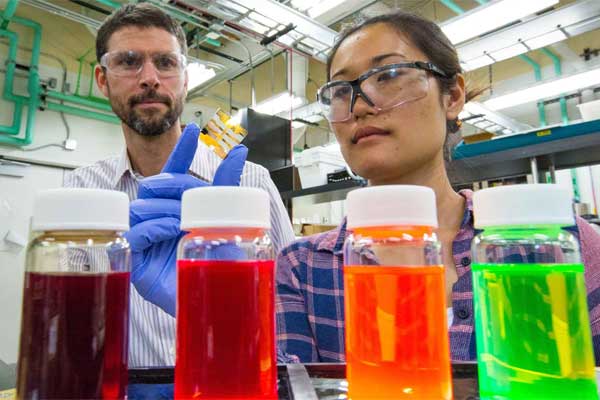Researchers at the U.S. Department of Energy’s (DOE) National Renewable Energy Laboratory (NREL) established a new world efficiency record for quantum dot solar cells, at 13.4 percent.
Colloidal quantum dots are electronic materials and because of their astonishingly small size (typically 3-20 nanometers in dimension) they possess fascinating optical properties. Quantum dot solar cells emerged in 2010 as the newest technology on an NREL chart that tracks research efforts to convert sunlight to electricity with increasing efficiency. The initial lead sulfide quantum dot solar cells had an efficiency of 2.9 percent.
Since then, improvements have pushed that number into double digits for lead sulfide reaching a record of 12 percent set last year by the University of Toronto. The improvement from the initial efficiency to the previous record came from better understanding of the connectivity between individual quantum dots, better overall device structures and reducing defects in quantum dots.
The latest development in quantum dot solar cells comes from a completely different quantum dot material. The new quantum dot leader is cesium lead triiodide (CsPbI3), and is within the recently emerging family of halide perovskite materials. In quantum dot form, CsPbI3 produces an exceptionally large voltage (about 1.2 volts) at open circuit.
“This voltage, coupled with the material’s bandgap, makes them an ideal candidate for the top layer in a multijunction solar cell,” said Joseph Luther, a senior scientist and project leader in the Chemical Materials and Nanoscience team at NREL. The top cell must be highly efficient but transparent at longer wavelengths to allow that portion of sunlight to reach lower layers. Tandem cells can deliver a higher efficiency than conventional silicon solar panels that dominate today’s solar market.
This latest advance, titled “Enhanced mobility CsPbI3 quantum dot arrays for record-efficiency, high-voltage photovoltaic cells,” is published in Science Advances. The paper was co-authored by Erin Sanehira, Ashley Marshall, Jeffrey Christians, Steven Harvey, Peter Ciesielski, Lance Wheeler, Philip Schulz, and Matthew Beard, all from NREL; and Lih Lin from the University of Washington.
The multijunction approach is often used for space applications where high efficiency is more critical than the cost to make a solar module. The quantum dot perovskite materials developed by Luther and the NREL/University of Washington team could be paired with cheap thin-film perovskite materials to achieve similar high efficiency as demonstrated for space solar cells, but built at even lower costs than silicon technology — making them an ideal technology for both terrestrial and space applications.
“Often, the materials used in space and rooftop applications are totally different. It is exciting to see possible configurations that could be used for both situations,” said Erin Sanehira a doctoral student at the University of Washington who conducted research at NREL.
The NREL research was funded by DOE’s Office of Science, while Sanehira and Lin acknowledge a NASA space technology fellowship.
NREL is the U.S. Department of Energy’s primary national laboratory for renewable energy and energy efficiency research and development. NREL is operated for the Energy Department by The Alliance for Sustainable Energy, LLC.













Comments